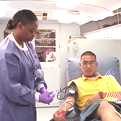
American Red Cross: Make Blood Donation Part of Holiday Plans
With the Fourth of July weekend here, the American Red Cross is urging everyone to make giving blood part of their holiday plans.
According to the Red Cross, the number of people giving blood is down, but the need still exists. On any given day an average of 39,000 units of red blood cells are needed for patients in the United States, even on holidays. Blood helps cancer patients, surgical and trauma patients, burn victims, people with blood disorders, and many others. Age is not a determining factor--blood can help a newborn infant or someone's grandmother.
To give blood, you must be at least 17 years of age, weigh at least 110 pounds, and be in good health. Some states allow 16-year-olds to give blood with parental consent. If you have given blood before, it must be at least 56 days since your last donation.
You can also give a special donation called apheresis. This process takes a little longer and the donor gives only platelets. Platelets last for only five days and many of these donations are used to help patients undergoing chemotherapy.
Here are some important facts to consider when deciding whether to donate blood:
- Every two seconds someone in the U.S. needs blood
- One blood donation may help save as many as three different lives
- Blood has a shelf life just like the food you eat. Red cells last 42 days, platelets only five days
- The number of people giving blood drops around a holiday, but patient need doesn't.
- Blood donors give about a pint of their blood
For more information, or to find a blood or platelet donation opportunity, call the Red Cross at 1-800-GIVE LIFE or visit www.givelife.org.